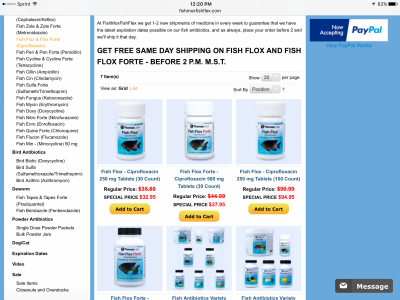Just something to keep in mind, but under dosing and or lack of treatment time are two of the biggest factors for resistance buildup. I would venture a guess we're starting to get to the point with aqua-cultured BTAs that it is something we would need to start thinking about.
Secondly if physicians were doing a very good job of limiting prescriptions we wouldn't be in the Xanax crisis we're currently in where they're about as common as tic-tacs.
The data we have is simply the data we have. I think all of us would love to have a formal study on infectious diseases that affect all of our reef inhabitants. Sadly I think we all know, there's not enough money to be made in that for anybody to take up that mantle. As a result the best information we're going to get is hobbyists with some kind of medical background or knowledge testing to the best of their abilities and sharing their results with the reefing community for others to test. If you think you can get it to work on a lower dose, then by all means knock yourself out. I know in all my tests anything lower then the recommended wasn't sufficient in a statistically significant number of tests compared to my total number of tests. Honestly I had better success with going straight to 500mg then I did starting with 250, but it wasn't a large enough difference for me to change the original protocol. So we can speculate all day about limiting antibiotic and this, that and the other, but the reality is, the information we have is what we have and all we can do is share our information and recommendations with the community and let you guys do with it what you want.
You may also find it worth noting that Cipro pills are available medically in 3 sizes, 250, 500 and 750. It's cheaper to by 500mg followed by 750mg followed by 250mg. It's still cheaper then dirt, but that's direct from manufacturer pricing.
Again though, the minute you start getting into the back in forth about reefers use of antibiotics and the ethics of how we're using what we use, I start to point back at "ripped from the ocean and into glass boxes for our enjoyment" and just kind of start to shake my head and nod.
Secondly if physicians were doing a very good job of limiting prescriptions we wouldn't be in the Xanax crisis we're currently in where they're about as common as tic-tacs.
The data we have is simply the data we have. I think all of us would love to have a formal study on infectious diseases that affect all of our reef inhabitants. Sadly I think we all know, there's not enough money to be made in that for anybody to take up that mantle. As a result the best information we're going to get is hobbyists with some kind of medical background or knowledge testing to the best of their abilities and sharing their results with the reefing community for others to test. If you think you can get it to work on a lower dose, then by all means knock yourself out. I know in all my tests anything lower then the recommended wasn't sufficient in a statistically significant number of tests compared to my total number of tests. Honestly I had better success with going straight to 500mg then I did starting with 250, but it wasn't a large enough difference for me to change the original protocol. So we can speculate all day about limiting antibiotic and this, that and the other, but the reality is, the information we have is what we have and all we can do is share our information and recommendations with the community and let you guys do with it what you want.
You may also find it worth noting that Cipro pills are available medically in 3 sizes, 250, 500 and 750. It's cheaper to by 500mg followed by 750mg followed by 250mg. It's still cheaper then dirt, but that's direct from manufacturer pricing.
Again though, the minute you start getting into the back in forth about reefers use of antibiotics and the ethics of how we're using what we use, I start to point back at "ripped from the ocean and into glass boxes for our enjoyment" and just kind of start to shake my head and nod.




















